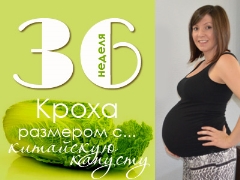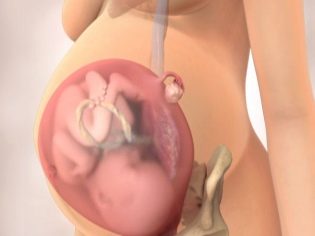36 week of pregnancy: what happens to the fetus and the expectant mother?
At the 36th week of pregnancy, all thoughts of a woman are occupied with the upcoming birth. It is time to decide on obstetric institution, read reviews of women in labor, visit the selected maternity hospital and sign the exchange card. Do not hesitate, because the baby can "want" to our world at any time.
At this time, according to statistics, about 10% of babies are born, and in case of multiple pregnancies, the probability of giving birth this week is as much as 30%.
How many months is it
The third trimester continues. 35-36 obstetric week of pregnancy completes the ninth obstetric month. By the more usual calendar standards, 8 months and a week passed, 34 weeks went from conception. The rule of the Negale, which is used by obstetricians, states that pregnancy lasts 280 days from the first day of the last menstruation. Thus, obstetric pregnancy lasts 10 months, and not 9, as is commonly believed.
Before the birth, a woman remains quite a bit - about a month. The estimated date of birth, which is calculated according to the above rule, is only a rough guide for the expectant mother and the doctors who observe it. In fact, only 5% of women give birth strictly in the DA, in all other cases, childbirth occurs either earlier or later than the specified period.
Therefore, it is difficult to unambiguously answer the question of how much is left before birth, if the beginning of the 36th week of pregnancy is. They can happen in a few days, and in a few weeks - everything is entirely individual. What is happening now with a woman and her baby?
Feelings of the future mother
Even very patient and philosophically minded women at week 36 begin to “whine”, complain and complain of intolerable fatigue. Everyone understands that it is better for a child to be full-term before 40 weeks, but the desire to give birth quickly now is beyond common sense. It becomes difficult for a woman to walk, do household chores, and even sleep does not bring relief, since most expectant mothers are now beginning to suffer from insomnia.
About one-third of women in the 36th week “sink” belly. This means that the baby is lowering in the uterine cavity, pressing its head against the exit of the small pelvis. Lowering the uterus below reduces the height of its bottom, it immediately becomes much easier to breathe, heartburn disappears, but the pressure on the pubic bone and bladder increases.
If a baby decides to go down this week, it does not mean that he is in a hurry to be born. It may take several weeks from the moment a baby drops to birth.
Thus, only a third of pregnant women begin to feel lighter. For the rest, you have to stick and brave yourself: all the “charms” of late terms this week will open in all its glory.
Fetal movements
Motor activity of the fetus has decreased markedly. The baby can no longer make sweeping movements and coups. The uterus has become very cramped and uncomfortable. Therefore, the crumb spends most of the time in a compact flexion posture, pressing the legs to the tummy and pressing the chin to the chest.His movements now bring future mother inconvenience: they can be painful and unpleasant.
However, such rare movements still need to continue to count daily. They should still be at least 10 in 12 hours. The rules for counting by this date are usually already well known to the expectant mother: the baby’s hiccup for movement is not considered, and a series of 2-3 movements is considered not as several episodes, but as one movement.
The causes of deviations in the motor activity of the child may be different. The most common thing in hypoxia. Oxygen starvation at the initial stage causes too frequent movements, sharp and painful. So the crumb tries to get more oxygen, massage the placenta with the hands. If the hypoxia is already long and deep, then the activity of the baby is reduced. So the child begins to save oxygen, the protective mechanism "works".
Hypoxia is extremely dangerous for the fetus, because it can cause irreversible processes in the brain, nervous system and even lead to the death of a child. The oxygen deficiency found in time allows doctors to make a quick decision about early delivery to save the baby. That is why doctors and women recommend every day to read the movements of their child, write the result in a table that can be obtained in the women's consultation or say and print on the Internet.
However, a decrease or increase in activity is not always caused by oxygen deficiency. Anything can affect the movement of the child, or rather his desire to make movements: the weather outside the window and the level of atmospheric pressure, the future mother's state of health, her diet, mood, and general condition. If a woman herself wants to sleep, her baby will also nap.
The daily routine is now the same for mom and baby, although there are exceptions - babies who stubbornly don’t want to sleep at night. With a high degree of probability, such a regime will continue in the child even in the first weeks after his birth.
Pains
Pain in the 36th week of pregnancy is present in every woman, even if the pregnancy proceeds without complications, abnormal weight gain and other “troubles”. The organism of the future mother, as a brave cosmonaut, courageously undergoes enormous overload. The sensations this week are rather uncomfortable, women feel like “seals” and “hippos”, fatigue is increased.
The uterus, although now more slowly, but continues to increase in volume, but because the ligament apparatus, which holds the reproductive organ, is greatly stretched. This causes mild aching pain in the lower back. If a woman has to stand for some time or sit in one position, her back will hurt. This pain is breaking. In the field of the coccyx and lower back pulls, tingles and aches a few times a day.
And because a woman should not go far from home, so that at any time she had the opportunity to lie down, rest, take a nap in order to improve her condition.
Training bouts, familiar not by hearsay to the vast majority of pregnant women, may become more frequent at 36 obstetric weeks. Do not be afraid: the pregnant woman's body is preparing for an important process, which is the birth.
An interesting regularity: in pregnant women the firstborn, there are almost always false contractions, they begin long before the birth, so by the 36th week the future mother has time to get used to them. But during the second or third pregnancy Braxton-Hicks cramps may first appear right now or a week or two later.
Training fights harbingers of childbirth can not be considered. They have no effect on the dilation of the cervix, do not cause the processes of smoothing the cervix and its shortening. You should not worry even if there are no training fights at all: there are women who do not have false fights, but this does not affect the process of childbirth in any way.Symptoms of false contractions are as follows: the uterus comes to a short-term tone, the stomach "stiffens", after a few seconds or minutes the fight recedes and does not return. This is the main difference between such fights and real ones.
If labor begins, the contractions will be repeated at regular intervals, and these intervals will become shorter and the contractions themselves will be more painful.
It is easy to “fight” with false fights: it is enough to drink “No-shpu”, lie quietly for half an hour, read a book or watch TV, take a warm shower. If the fight is genuine, not training, such methods will not bring any result.
Crotch pain is another common complaint at week 36. The pubic bone hurts because of the pressure of the head of the fetus, and also because of the specific process of divergence and softening of the pelvic bones. Under the action of the hormone relaxin, the ligamentous and bone apparatus becomes more mobile, this is necessary so that in childbirth the baby’s head can leave the pelvis. Women note that pubis hurts more at night when a woman goes to bed, and also in the morning when it comes time to get out of bed. Sometimes it is difficult to walk, but severe pain usually goes away if you “disperse.”
If the pain is constant, acute, it is impossible to endure it, while movement is hampered, you should definitely inform your doctor about it, the development of symphysitis is not excluded - the dangerous divergence of the pelvic bones, in which a woman is recommended to give birth by caesarean section.
Leg pain at obstetric week 36 is usually worse. The weight of a fruit grows, as well as own weight of future mother. Knee joints and ankles with great difficulty withstand such a load, the arch of the foot slightly flattens, and therefore shoes that are always “comfortable” on the foot may become uncomfortable. To cope with this, a woman needs to rest and sleep more often with her legs raised, placing a small pillow or bolster from the plaid under them.
If a toothache hurts at week 36, you must visit a dentist. Dental treatment at a later date is considered dangerous from the point of view of the likelihood of a sudden onset of labor, because visiting the dentist is always a big stress for the expectant mother. Any severe pain, no matter in which part of the body it is located, is a reason for going to the doctor. If the acute pain is accompanied by strange, incomprehensible secretions other than the usual, you should immediately call an ambulance.
Among the new sensations at the 36th week of pregnancy is "pricking with needles" in the vagina. That is how future mothers describe these unusual and frightening feelings. It is about preparing the cervix for the upcoming delivery. Small tingling is a sign of gradual softening of the neckits smoothing and shortening.
Allotment
A woman at 36 weeks should be especially closely watched for secretions, as often the first symptoms of beginning labor are the discharge or leakage of amniotic fluid, the withdrawal of the so-called mucus plug. In this pregnant, simple hygiene products will help - thin pads. They clearly "show" any changes in the nature of vaginal secretions.
If a few weeks ago, the amount of discharge has become more abundant, then now they can cause mucus. Impurities of mucus talk about the beginning of the discharge of mucus plug - a layer that tightly closes the cervical canal throughout pregnancy. It begins to expand under the action of estrogen shortly before birth. If a whole lump of mucus is found in the discharge, this indicates a complete discharge of the mucus plug. From this point on you should be extremely cautious: childbirth can begin at any time, douche and sex should be avoided so that the infection does not penetrate into the uterine cavity.
But not always the preparation for the generic process in the body is manifested by the discharge of the mucous membrane.Sometimes it departs simultaneously with the waters and by itself can go unnoticed. The waters, in turn, flow away either wholly (this is a decent amount of liquid) or in parts (on the gasket there will be wet stains with no color or smell).
Normal for the specified period are the discharge light, homogeneous consistency, no odor or accompanied by a slight fermented milk smell. Spotting almost always indicates the beginning of labor, placental abruption, cervical trauma. Greenish discharge, dirty gray with itching and unpleasant smell is a sign of genital infection, and white yeast-like discharge with itching is thrush.
Any abnormal discharge should be a reason for unscheduled visits to the doctor, putting on a smear for analysis and starting treatment.
Therapy is urgent, because the health of the baby depends on the cleanliness and health of the genital tract, which will be promoted during childbirth. Bloody and watery discharge - a reason to immediately take a horizontal position and call an ambulance - you need immediate hospitalization.
Psychological state and mood of pregnant
36 weeks of pregnancy does not add optimism to the woman, because childbirth is not far off, and the fear of them is growing rapidly. In Russia, it is not customary to apply to specialists with such fear, it is considered something shameful, because in public understanding, the future mother must be courageous and resolute, ready to do anything for her baby. All over the world, the practice of addressing a psychologist with the fear of birth pain is quite normal. A psychologist works in every female consultation. Admission is free of charge, and therefore you should not think in stereotypes.
If the fear is strong and the woman cannot cope with it, the best thing is to contact a specialist who will tell you how to relax, stop being nervous and harass yourself and those around you with empty panic.
In general, the character of a woman at a later date deteriorates somewhat. A pregnant woman becomes capricious, demanding, irritable, tearful, intractable and very touchy. That is why in the last month of pregnancy the number of misunderstandings in relationships, family conflicts is rapidly increasing, because men simply physically cannot feel what their wives feel at that moment, and, accordingly, it is not easy for them to understand them.
It is becoming more and more difficult for a woman to enjoy small things like a delicious chocolate bar or a good movie. She is already pretty tired from carrying a baby, I want to feel the lightness again. Dependent position, which is now falling pregnant, constantly in need of help to put on shoes, pick up a package with products, does not contribute to self-confidence and joyful mood.
The best that relatives can now do for the expectant mother is to suffer her forgetfulness, temper, claims and resentment. Everything will pass as soon as the baby is born. Other cares will appear, the hormonal background will change and the normal mood will gradually return.
Changes in the body
The body of a pregnant woman is in full swing preparing for childbirth. These processes are invisible and occurring at a thin cellular and hormonal level, but rather swift. Progesterone, which over the entire period ensured the safety of pregnancy, created a normal "environment" for the development of the baby, begins to be produced significantly in smaller quantities.
But the concentration of estrogen increases, which now "fill" with all the preparation, which involves the muscles, ligaments, the skeleton of the future mother, her uterus, reproductive tract, mammary glands, heart, blood vessels, bone marrow and brain.
Uterus growth
The uterus does not grow as fast as before. The height of its bottom this week is 34-36 cm. The bottom props up the chest, the distance from the navel line to the extreme line of the uterus is already about 17 cm.If the stomach is not "lowered", then this position of the uterus leads to great difficulties for a woman: it is difficult to breathe, she suffers from heartburn, because the large uterus squeezes the diaphragm and stomach.
Almost the entire abdominal cavity, the woman is occupied by the uterus, the other internal organs are displaced, compressed. The inability to make a full breath causes the woman to have the obvious feeling that she does not have enough air. If you can not sleep with an open window (on the street in winter, for example), then A woman is recommended from time to time to take a knee-elbow posture and take several slow deep breaths and exhalations in it. This will avoid dizziness caused by lack of oxygen. Dyspnea will decrease when the baby drops its head closer to the “exit”.
One of the most "suffering" in this period is the future bladder mother. This organ is so strongly squeezed by the uterus that urination becomes frequent, the woman cannot “suffer” at all, and at the most inappropriate moments there can occur “troubles” such as involuntary urine leakage if the pregnant woman coughs or laughs. "Goes" and intestines. Its loops are strongly pushed back, squeezed along the front wall, as a result of which the woman is tormented by constipation.
The pressure of the uterus and the baby’s kicks in the region of the liver and gallbladder are not just painful, they also cause disturbances in the flow of bile, which manifests itself in periodic indigestion - diarrhea, nausea. The pressure of the uterus disrupts the blood supply to the lower body, as a result of which hemorrhoids and varicose veins develop quite often.
The most massive changes at obstetric week 36 occur with the cervix. Its maturation is in full swing. By some signs, doctors can now judge the likelihood of imminent labor. The length of the cervix is normal now in the range of 26-27 mm. But the neck is shortened. If its opening occurs, then by how many fingers the obstetrician misses the neck, it is concluded when it is about to expect a baby to be born.
If a woman was previously diagnosed with cervical insufficiency and was put on a pessary on her neck or had surgical sutures, more careful monitoring is now required.
Many pregnant women with such a problem recommend early hospitalization so that in-hospital doctors prolong the pregnancy to the maximum, after which they can remove the stitches or pessary and wait for early deliveries.
A short cervix, the length of which is significantly less than the norm, is a sign that labor will start before the day defined as intended for childbirth. A long neck may indicate that pregnancy may not be limited to 40 weeks.
Weight gain
Weighing in at week 36 is recommended every day. This is important in order to notice possible complications such as preeclampsia in time, because internal edema can often be detected only by sharp fluctuations in body weight. The numbers on the scales by this time are inevitably frightened by most pregnant women. In order to better understand where they came from, a woman should know that her weight is now formed immediately from a number of "compelling reasons."
Approximately one third of the mass added to the woman’s initial weight is the weight of the fetus. The placenta and the amniotic fluid together are also “invested” in the common cause: their weight is approximately 11% of the increase. The increased amount of blood circulating in the body of the future mother is about 12% of the increase, more than 5% is allocated to the weight of the mammary glands. Women's own fat reserves are actually small. They account for only about 4% of the increase.
The fluid that accumulates outside cellular structures takes about 13%. It is from it that you need to get rid of the maximum, if there is a tangible "advantage", the increase is pathological, or swelling has appeared.
What should be the weight gain normal for the specified term? The answer to this question lies in the features of the constitution of the woman herself.If, before the onset of the “interesting position,” the lady was thin and petite, her weight could increase by 13.5 kg. For future mothers who did not have problems with extra pounds, but who were not very skinny either, the regulations “allow” to gain no more than 12 kg plus their mass by this week. Women who had obesity before pregnancy had problems with overweight, you can gain no more than 8 kg by the 36th week.
Every week a woman can add no more than 300 grams. To "fit" in such a rigid framework, right now you need to eat less high-calorie food, because the baby is growing and gaining weight very dynamically. The problem of overweight during pregnancy is not at all exaggerated, it is not necessary to assume that doctors so "scare" future mothers. Extra pounds complicate the process of childbirth, make the recovery period longer. If preeclampsia develops, then there is a danger of placental detachment, fetal hypoxia, its death, convulsive syndrome in the most pregnant. Gestosis is not in vain considered to be one of the "leaders" because of the mortality of mothers and babies.
If your legs, arms, and face swell at week 36, you should definitely visit a doctor and pass a general urine test. Protein in the urine is a sure sign of preeclampsia. And then everything will depend on the degree and manifestations of complications. With a small edema, a pregnant woman may very well carry the baby to a deadline, and with pre-eclampsia, an urgent delivery is indicated.
Other changes
The breast of a woman begins to change rapidly. It was already large, but now the glands enlarge and become more sensitive. Nipples grow coarse, colostrum can be released. The likelihood that colostrum will be greater, higher in multiparous, because the ducts of their mammary glands are wider, and the nipples, weakened by breastfeeding of the first child, are not able to hold the nutrient fluid inside.
Colostrum, which was yellowish and thick, at week 36 may change and become more liquid, white. This is a normal process, after delivery this substance will become breast milk, but not immediately. For the first few days, the baby will consume exactly colostrum, which fully corresponds in its composition to all the needs of the newborn.
There is an erroneous opinion among women that if there is no colostrum in the later periods, then lactation can cause serious problems. These two things are not interconnected. As for a large amount of colostrum, this should also not be a reason for experiencing. If it causes physical inconvenience, smearing a woman’s clothes, leaving greasy and stubborn stains on her, then you can wear a bra for nursing mothers, which has special inserts that will help to completely solve the problem.
Headaches at obstetric week 36 are a consequence of increased blood volume, as well as instability of blood pressure. The load on the heart and blood vessels is now great as ever, the heart beats more often. The general condition does not contribute to the compensation of these differences, there are headache, dizziness, a feeling of weakness and fatigue.
Resting a woman is recommended in a darkened room, which is well ventilated, in a horizontal position. This contributes to a marked improvement in well-being.
Hemoglobin in the blood begins to rise gradually. Even if a week or two weeks ago, a woman was told that she had pregnant women with anemia, now hemoglobin is growing noticeably. In this regard, bouts of dizziness, cyanosis, "circles" under the eyes recede, the state of health improves. The hemoglobin rate for women "in position" starts from 109 g / l. However, still in the diet of the future mother should be in sufficient quantities to contain foods that contain a lot of iron: buckwheat, pomegranate juice, green apples, persimmon, beets, liver.
Under the action of estrogen in women can begin to grow hair faster, and, unfortunately, not only on the head.All places where physiological hair distribution is present can become more “shaggy”. At the same time, there is a noticeable lack of calcium: the nails begin to break, the skin becomes drier and more vulnerable, the gums bleed while brushing the teeth, and the legs “craze” with cramp almost every night.
The susceptibility of a pregnant woman to various allergens increases. Even a small amount of pollen or house dust can cause a cough, runny nose, and skin spots.
Now it is necessary to exclude the use of new cosmetics, creams, and the number of tested and familiar cosmetics should be minimized.
The sweat and sebaceous glands of a pregnant woman are very active during this period. This fact requires a woman to strictly follow the rules of personal hygiene. Women at week 36 often appear dandruff, moles and freckles become brighter.
Baby development
Baby every day sets new records for weight gain. At week 36, it gets harder by another 200-300 grams. Such an increase is now characteristic of each of the remaining weeks. The weight of the fetus at 36 weeks of pregnancy is approaching 3 kg. Most often, the estimated weight of the fruit at this time is 2700 - 2900 grams. But these norms are quite conditional. Some babies manage to reach a weight of more than three kilograms, and some (quite normal and healthy) barely reach 2.5 kg. Growth of babies on average this week is 45-48 cm.
Baby is almost ready to be born. It looks like a newborn, its organs and systems are formed and functioning. However, for him, of course, it is better to spend a few more weeks in a comfortable mother’s womb, because now the crumb has reached his own “finish line”: he is learning to adapt to new conditions that are waiting for him from the first seconds after birth.
What does baby look like
At week 36, your baby is a pretty cute, fairly plump and cute creature. Subcutaneous fat has accumulated sufficiently so that the baby has lost thinness, cheeks and pop. Hands, legs became more plump, the stomach grew. The skin got a pink tint, the folds and wrinkles on it smoothed out, the blood vessels no longer “peep” through the layers of the skin.
The skin itself has become more durable and smooth, this week the baby will almost completely get rid of lanugo - the original hair. Together with the loss of these thin hair, there is a noticeably less cheese-like lubricant. Now fatty grease is present only in those places where mechanical irritation is possible due to friction: under the arms, under the chin, in the folds of the arms and legs under the knees, as well as in the inguinal zone.
So now looks about 90% of the fruit. However, there is another 10% - they have not yet dropped lanugo or only a small part of it fell out.
If a baby is born with fragments of hair, nothing terrible will happen: these thin hairs, which are popularly called “baby bristles”, will fall out in the very first weeks of independent life of the baby outside the womb.
In some babies, on the 36th week, the hair on the head grows actively, their length can reach five centimeters and it is already quite obvious that the baby will be brunette or blond because the hair has pigmentation. The auricles and nose became harder, the cartilaginous tissue of the baby in this period of hardness almost came close to the cartilage of the newborn. Kids now differ from each other in unique, peculiar facial features, eye color. Each has its own individual pattern on the fingertips (fingerprints), the cilia are longer, there are eyebrows, nails grow. This week, the nail plate already protrude beyond the phalanges.
The body of the baby has become more proportionate. The lower limbs are now longer than the upper ones, the head has normal forms, although the bones of the skull are still quite soft and mobile.This is necessary so that the head of the baby without problems for the brain passes through the birth canal. The pose the baby is in is not very comfortable for him, but it is a necessary necessity. Now the baby is grouped to the maximum, because he has yet to spend about 4 weeks in the uterus.
Presentation of the fetus
The position that the baby now occupies in the uterus, with a 99% chance will continue until the birth. Preposition head when the baby is located to the exit from the small pelvis head, - most naturally, the vast majority of children are in this position now. If the doctor states that the baby is in a pelvic presentation or it is located transversely in the uterus, at week 36 it will be determined which way the delivery will take place.
Pelvic and transverse presentation - indications for cesarean section. Independent birth can be a danger to the health of the baby and his mother. Such crumbs pose the likelihood of severe disabling birth injury, as well as acute hypoxia, the consequences of which are in most cases irreversible and sometimes fatal to the child. A woman is given an approximate date of a cesarean section.
This usually occurs as planned between 38 and 39 or 39 and 40 weeks. It is important to have time to carry out the operation precisely as planned, without waiting for the independent childbirth to begin. Otherwise, the operation will have to be done in an emergency mode.
Women, whose baby is now "wrong", are concerned about the question whether the child can still turn to a position more suitable for birth. Such a possibility exists, but, alas, it is minimal: in the uterus it became too crowded for such changes in body position. However, the doctor will still recommend a special gymnastics, standing in the knee-elbow position (cat pose) - In rare cases, this contributes to the change of the fetus.
Nervous system
At obstetric week, the baby’s nervous system is almost formed and works successfully. The imposition of nerve endings with a special substance, myelin, has ended. The brain “got heavier”, the bark of the big hemispheres “got” the brains and furrows. New nerve cells continue to appear - neurons. They form neural connections. Thanks to this process, the baby can already survive if it decides to be born prematurely. After all, reflexes are also responsible for neural connections. Now the baby has already formed several dozen different reflexes, and this process does not stop.
The baby has sucking and swallowing reflexes, the grasping reflex is well developed. Dozens of tendon and muscle, as well as tonic reflexes provide motor activity.
The skin of the baby reacts to changes in temperature, to touch, to pain due to the development of nerve endings. If the umbilical loops accidentally touch the palms or the feet of the crumbs, his fingers reflexively diverge in different directions, spread out in the form of a fan. If the umbilical cord touches the lower abdomen, the baby bends even more, trying to close the most important and weak point in the human body - the abdominal cavity.
In the brain, reflectively "work" links with the centers of breathing, logic and thinking, as well as with the centers responsible for the recognition of human speech. The time is long past when all the nervous processes in the body were “managed” by the spinal cord. Now they are controlled by the brain. It receives signals from all organs and systems, from the senses. The kid hears well. He reacts to the voice of mom, father, scared by unfamiliar voices and loud sounds. His vision is still limited to the perception of color spots, but already there is the smell and taste preferences. The organization of the nervous system of the child is already purely individual, and it will appear immediately after birth.
Internal organs
The formation of internal organs was completed in the embryonic period.Since then, the baby has gone a long way in the development of the functional abilities of all the organs of his small organism. The testicles in the male fetus at week 36 in most cases have already been lowered into the scrotum. This can be assessed during the ultrasound. If the genital glands of the baby are still outside the scrotum, in the small pelvis, where they migrated from the abdominal cavity, this is no reason for concern: the testicles descend to the birth of most boys.
All internal organs increased in size. The formation of the liver lobes and all the structures of the kidneys is completed, the baby’s lungs continue to accumulate surfactant. It has already been accumulated in sufficient quantity so that the baby, in the event of its premature birth, can breathe on its own, but for the smooth operation of the lungs it is necessary to dig a little more surfactant. This process will continue throughout the last weeks of pregnancy.
Kid's kidneys produce more than half a liter of urine per day. The amount of amniotic fluid, where the baby is pissing, gradually begins to decrease. At the expense of the kidney's fluid, the amount of the baby is maintained at a normal level for a given gestation period. The waters renew their composition every 3 hours, and due to this, a sterile environment is maintained inside the fetal bladder that is completely safe for the child.
The kid trains the swallowing and sucking reflexes several times a day, because they will not let him die of hunger after his birth. Baby sucks cams, swallows amniotic fluid. It enters the stomach, from there - into the intestine.
Undigested lanugo particles are deposited along with the bile in the intestine as the very first feces, which has a dark green color and is called meconium. The baby will begin emptying the intestines after birth. Meconium will be released on the first day after his birth. In some cases, for example, during rhesus conflict, entanglement with umbilical cord, hypoxia, the baby performs an act of defecation right in the womb. The waters become turbid and green. This condition requires early delivery.
A small heart is fully formed, only the “oval window” remains open. It will close in the first year of the child’s life. The heart pumps more than 20 liters of blood per day.
Viability
Fear of preterm birth at 36 weeks is not worth it. Children born in this period are quite viable. Complications for a small organism after giving birth at week 36 can also be avoided. They happen quite rarely. The lung tissue and nervous system are ripe enough to help the child survive in a new habitat. Subcutaneous fat, which made the baby plump and cute, will help him to keep warm and not supercool.
However, the mother should be prepared for the fact that her baby, who decides to be born this week, will be shown a special medical control. In the first few days he will be in the intensive care unit under the supervision of neonatologists. He will be placed in a special heated bed, so that the baby is warmer, because he still has less subcutaneous fat than the babies are a month older by the duration of gestation.
If there are problems with breathing, he will be provided with oxygen and food through a probe. However, you should not be afraid of this: the chances of surviving and growing healthy and strong in a child are very high.
Your baby on ultrasound
The main examinations were left behind and ultrasound as well. But at 36 weeks of pregnancy, such a study may still be needed. If the doctor insists on an emergency delivery, an ultrasound scan is performed in order to assess the degree of maturity of the lungs, the position of the fetus and its estimated weight. Ultrasounds can now be recommended for women with a previously diagnosed “intrauterine growth retardation” to evaluate how a baby has grown. In case of multiple pregnancies, during pregnancy after an IVF ultrasound is performed more often than during normal pregnancy.This week, a control ultrasound can be performed on such women to assess the readiness of the fetus or fetus for childbirth.
The standard protocol still includes fetometry, an assessment of its physical activity and cardiac activity, the state of the placenta (it has already begun to age and develop its resource), the amount of amniotic waters, and the baby's presentation.
The rates of fetometry at 36 obstetric weeks are presented in the following table:
BPR, mm | LZR, mm | Thigh length, mm | The length of the bones of the tibia, mm | The length of the humerus, mm | The length of the bones of the forearm, mm | Head circumference, mm | Abdominal circumference, mm |
82-97 | 103-124 | 64-74 | 58-66 | 57-67 | 50-58 | 202-348 | 291-354 |
Such values are considered average norm, your child may be larger or, conversely, miniature compared to them. A normal deviation from the norms is considered a deviation of no more than 2 weeks. The amniotic fluid index at week 36 is 10-20 cm, the thickness of the placenta is 28-46 mm, the degree of its maturity is 2-3. The external and internal cervix of the cervix according to the results of ultrasound diagnostics should be closed.
If now a woman wants to know the sex of the child, then it will be difficult to consider sex differences. The baby is in a position in which his genitals are covered with legs and umbilical cord. The probability of erroneous establishment of sex on this period is high.
Hazards and Risks
Unstable and precarious gait, which at 36 weeks of pregnancy inherent to all expectant mothers, creates the danger of falling and injury. A woman because of the huge belly almost does not see her own legs, and this situation is most dangerous in winter, when it is slippery on the street.
Immune protection of a pregnant woman at this time is weakened, therefore the probability of getting acute respiratory viral infections, influenza, chickenpox, a bacterial infection increases, and even the most common cold can give a woman a lot of inconvenience. For fetal infections that are not sexually, in fact, are not as dangerous as they used to be, but for mom they are undesirable.
If you have a sore throat, a runny nose appears, the temperature has risen, you should definitely call the doctor on the house. He will tell you how and with what is the best treatment now, in order to avoid dangerous complications and not harm the treatment to the baby. Many medicines on this period are already allowed, but for each necessarily need to consult with your doctor.
Lifting weights, severe stress and experiences can now contribute to the onset of preterm labor - it is better to refrain from them. The main motto of this week is calm and tranquility! Only a healthy lifestyle and a reverent attitude to their health will help a woman to extend the baby's bearing to the due date. Harmful habits - alcohol and nicotine - also increase the likelihood of giving birth to a baby ahead of time.
At week 36, women can often bleed from the nose. Nosebleeds at this time are in most cases not dangerous and quite physiological. However, they must be informed of the attending physician. The attempts of a woman to combat constipation with laxatives are also dangerous at this time. Drunk magnesia or powerful medicines that thin the stool may provoke another extreme - diarrhea, which is now undesirable from the point of view of a high probability of dehydration.
Analyzes and surveys
Since a woman now attends a antenatal clinic about once a week, an urinalysis should be tested at the same frequency. Before each reception, a woman must look into the laboratory of the antenatal clinic and hand over a jar of research materials. Week 36 is no exception. This analysis, despite its simplicity, is very informative. The composition of the urine now the doctor will be able to assess how the woman's body works, whether the kidneys cope with increased stress, whether the woman has gestosis and gestational diabetes.
With the identified pathologies of the placenta, its premature aging, women are prescribed a blood test for hormones.If pregnancy is aggravated by complications, CTG can be assigned to a woman at week 36. If there were no complications and no, on CTG according to the plan come next week, 36-37 obstetric week.
The remaining tests are assigned according to individual indications. With a violation of hemostasis make a coagulogram. When the difference in Rh factors, if the mother is negative, be sure to examine the woman's venous blood for the presence of anti-rhesus antibodies.
Recommendations to the future mother
In the 36th week of pregnancy, in addition to all the above recommendations, the following tips can help a woman:
- Try to eat less foods with calcium content, as this can now lead to premature hardening of the bones of the baby's skull and greatly complicate the process of childbirth;
- the flight at week 36 is dangerous for a woman and a baby, so it is better to plan travels and trips for later;
- sex is not prohibited under the condition that the woman has no threat of premature birth and the mucus plug has not moved away (orgasm is useful for the pregnant woman, it helps the birth canal and the uterus to prepare for the birth); otherwise, and if the expectant mother has an obstetric pessary, intimate relationships are prohibited.
Pregnant Reviews
Many future mothers at week 36 complain not only about their general condition and deteriorating state of health, but also about the fact that now there is absolutely no appetite. In the people, it is believed that lack of appetite is a sure sign of fast delivery. In medicine, this is another explanation: the body begins to get rid of all the "extra" to the genera, cleanse.
Eat better in small portions, but regularly. Keep a balance of foods in the diet.
About what happens to the fetus and the future mother at 36 weeks gestation, see the following video.



































































